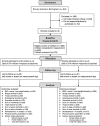Preventing childhood obesity, phase II feasibility study focusing on South Asians: BEACHeS
- PMID: 24722198
- PMCID: PMC3987740
- DOI: 10.1136/bmjopen-2013-004579
Preventing childhood obesity, phase II feasibility study focusing on South Asians: BEACHeS
Abstract
Objective: To assess feasibility and acceptability of a multifaceted, culturally appropriate intervention for preventing obesity in South Asian children, and to obtain data to inform sample size for a definitive trial.
Design: Phase II feasibility study of a complex intervention.
Setting: 8 primary schools in inner city Birmingham, UK, within populations that are predominantly South Asian.
Participants: 1090 children aged 6-8 years took part in the intervention. 571 (85.9% from South Asian background) underwent baseline measures. 85.5% (n=488) were followed up 2 years later.
Interventions: The 1-year intervention consisted of school-based and family-based activities, targeting dietary and physical activity behaviours. The intervention was modified and refined throughout the period of delivery.
Main outcome measures: Acceptability and feasibility of the intervention and of measurements required to assess outcomes in a definitive trial. The difference in body mass index (BMI) z-score between arms was used to inform sample size calculations for a definitive trial.
Results: Some intervention components (increasing school physical activity opportunities, family cooking skills workshops, signposting of local leisure facilities and attending day event at a football club) were feasible and acceptable. Other components were acceptable, but not feasible. Promoting walking groups was neither acceptable nor feasible. At follow-up, children in the intervention compared with the control group were less likely to be obese (OR 0.41; 0.19 to 0.89), and had lower adjusted BMI z-score (-0.15 kg/m(2); 95% CI -0.27 to -0.03).
Conclusions: The feasibility study informed components for an intervention programme. The favourable direction of outcome for weight status in the intervention group supports the need for a definitive trial. A cluster randomised controlled trial is now underway to assess the clinical and cost-effectiveness of the intervention.
Trial registration number: ISRCTN51016370.
Keywords: Children; Obesity; Prevention.
Figures
References
-
- Lobstein T, Baur L, Uauy R. Obesity in children and young people: a crisis in public health. Obes Rev 2004;5(Suppl 1):4–85 - PubMed
-
- NHS Information Centre for Health and Social Care. National child measurement programme: England, 2011/12 school year. The Health and Social Care Information Centre, 2012
-
- Dinsdale H, Ridler C, Rutter H. National child measurement programme: changes in children's body mass index between 2006/7 and 2010/11. Oxford: National Obesity Observatory, 2012
Publication types
MeSH terms
Grants and funding
LinkOut - more resources
Full Text Sources
Other Literature Sources
Medical

